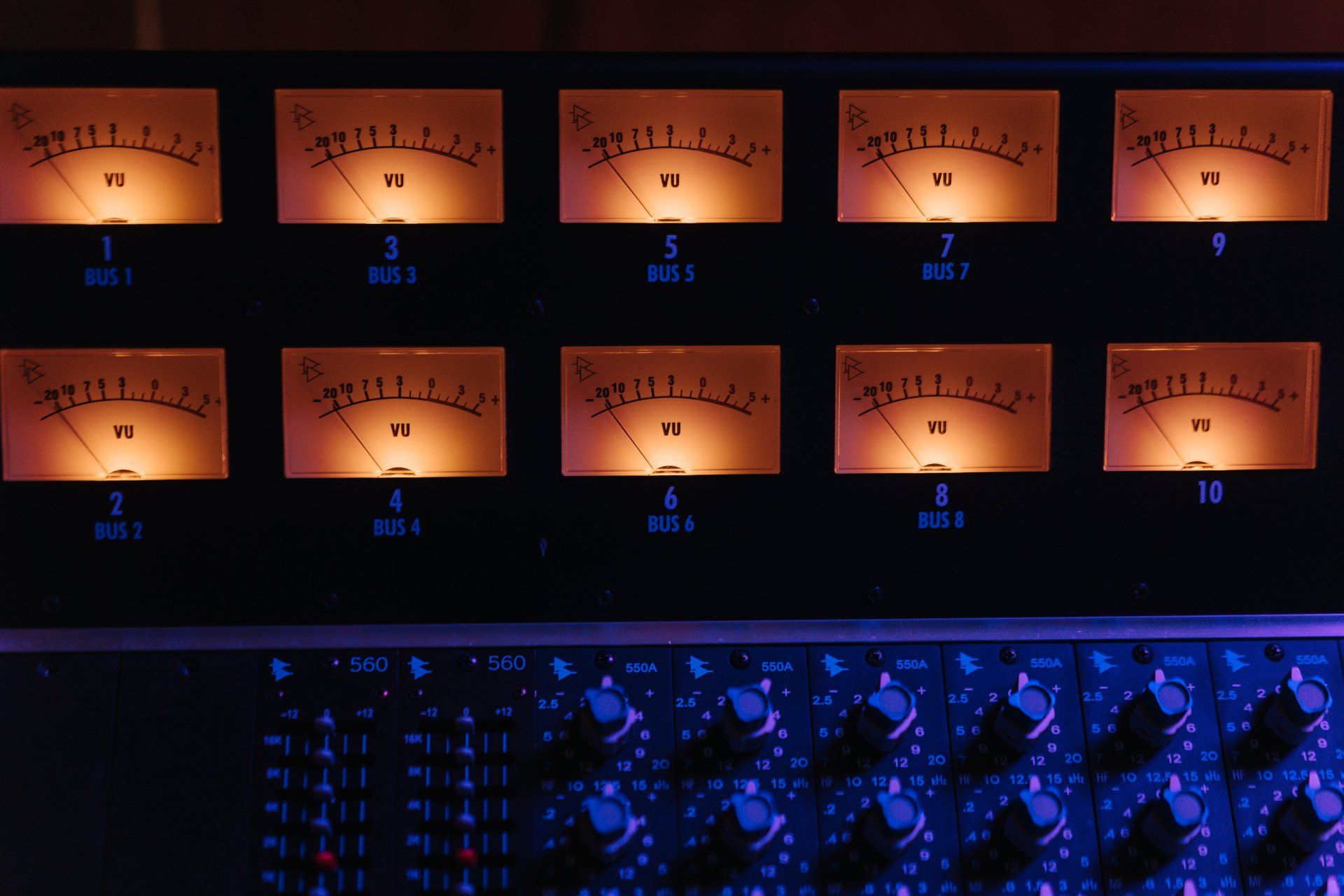
Mastering is the final stage of the music production process, and it can make all the difference between an amateur sounding mix and a professional, radio-ready track. As the last creative step before distribution, mastering polishes a mix and prepares it for the listener's experience across various playback systems.
While mixing involves balancing and processing individual tracks, mastering takes a holistic approach. Mastering engineers use specialized tools and global adjustments to enhance the overall sound quality, consistency, and perceived loudness of a song. Their expertise and fresh ears provide an objective perspective on giving mixes the final touches they need.
This guide breaks down the art of mastering into "4 C's" - clarity, consistency, color, and clipping/loudness. Understanding these concepts is key to elevating mixes and achieving professional masters. Whether you're a producer looking to DIY master your own tracks or better communicate with mastering engineers, the 4 C's provide a framework for success.
I. Clarity
Clarity refers to how clearly the listener can hear all the individual elements and details in a mix. It enables the message and emotion of the music to shine through. Mastering should enhance clarity by ensuring nothing obscures the core instruments and vocals.
Equalization (EQ) is essential for boosting clarity during mastering. Strategic EQ can attenuate problem frequencies that clutter or mask other elements. For example, a dip at 400-600Hz could tame muddy bass buildup, while a boost at 2-4kHz could increase vocal presence. Subtle EQ moves of 1-2dB can make a notable difference.
Multiband compression also helps increase clarity on specific frequency ranges. Compressing the low mids around 300-500Hz can tighten and control muddy resonances, cleaning up the low end. Gentle compression on highs above 10kHz can add sizzle and detail. The key is to compress transparently, avoiding pumping artifacts.
Modern mastering tools like iZotope’s Ozone provide dedicated modules for honing clarity. The “Spectral Shaper” applies smoothing EQ to suppress resonances and masking. The “Vintage Tape” module smooths out peaks and enhances punch. Used subtly, these processing tools can work wonders for opening up a dense mix.
A case study in exemplary clarity is the mastering on Daft Punk’s 2013 album “Random Access Memories.” Despite the record’s density of instruments and arrangements, every element shines through in a clean, polished way. The mastering perfectly complements the pristine production quality.
II. Consistency
A hallmark of professional mastering is ensuring a cohesive, consistent listening experience across different playback environments. Well-mastered music should translate well whether heard on phone speakers, car stereos, club systems, or audiophile headphones.
The most fundamental step is volume leveling. A mastering engineer will set the integrated LUFS loudness of a song to match industry standards, typically -14 LUFS for streaming. This gives adequate headroom and allows the track to play at an appropriate volume on any system.
Stereo imaging should also be checked to ensure a centered, coherent soundstage. Left-right balance can be adjusted, and extreme panning reduced if necessary. Subtle mid/side processing may help glue the stereo spread for a more consistent effect.
Mastering engineers must understand the requirements for different release formats. For example, streaming platforms mandate specific loudness levels, while vinyl has physical limitations like bass phasing when cut too loud. A separate vinyl-specific master may use less limiting and custom EQ.
A standout case of cross-format consistency is the 2012 vinyl reissues of Beatles albums mastered by Sean Magee at Abbey Road Studios. He created new masters specifically optimized for vinyl, retaining dynamics while holding up against modern remasters. This set a new benchmark in reviving classics.
III. Color
When we talk of color in mastering, we mean the subtle tonal and textural flavors that bring vibes and character to a track. Mastering can impart polish while retaining the unique sonic signature of the mix. Or it can intentionally steer the color to suit the intended genre or mood.
Analog processing is renowned for adding pleasing color. Subtle tube warmth, tape saturation, and the natural compression of analog gear gives a master that elusive vintage vibe. Many plug-ins emulate analog hardware, but discerning engineers use this coloring judiciously.
Strategic harmonic saturation helps make mixes sound more full and vivid. Restrained exciter effects can enhance brightness and detail. Natural sounding reverbs also widen the perceived space and depth. All of this adds color without undermining the integrity of the mix.
The mastering color fits the production style. A sparse, dynamic folk record retains breath and transparency but gains sheen via subtle analog processing. A pumping EDM anthem goes for smashed limiting, radical EQ, and hyper-compressed maximization of impact. Mastering aligns the finish with the sound.
For example, compare Metallica’s "...And Justice for All" original mastering versus the controversial 2018 remaster. The new version added more low end and clarity, dividing fans who felt it abandoned the album's original thin, cold, and harsh sound. This shows how altering a record's color radically transforms its vibe.

IV. Clipping and Loudness
One of the most hotly debated aspects of mastering is managing clipping and loudness. The ongoing “Loudness War” refers to the trend of overly compressed masters sacrificing dynamics for loudness over the decades. Mastering engineers must strike the right balance.
Clipping occurs when a signal exceeds 0dBFS, the maximum loudness possible without distortion. Some clipping may be inevitable to achieve competitive loudness, but excessive clipping ruins quality. Careful transient-controls, lookahead limiting, and conservative gain ceilings reduce clipping artifacts.
Modern loudness normalization by streaming platforms like Spotify places less emphasis on loudness maximization in mastering. The goal now is achieving an integrated LUFS level matching the platform standard, not just making the track as loud as possible. This shift allows retaining more dynamics.
A widely praised example of a modern loud master that preserved dynamics is Nils Frahm’s 2018 album “All Melody.” Despite its expansive, open sound, the album hits -14 LUFS loudness. The engineer chose where to compress while allowing peaks to breathe. This demonstrates loudness done right in the streaming age.
Ultimately, the listener’s experience determines ideal clipping and loudness levels. A mastering engineer’s expertise comes from navigating this complex tradeoff successfully across years of clients and genres. There’s no single right answer, only what’s best for the individual track and its intended purpose.
V. The Future of Mastering
As production and distribution models continue evolving, mastering also adapts. We'll briefly explore some emerging trends and future possibilities in the world of mastering.
The role of dedicated mastering engineers is changing but not disappearing. More artists are self-mastering using software, but professional mastering is still crucial for complex, high-stakes releases. Engineers provide an expert final polish.
Cloud-based mastering allows remote collaboration. Engineers can access session files from anywhere to master, followed by quick turnaround on revisions. This facilitates better communication between mixers and mastering engineers.
Intelligent algorithms may assist in tasks like volume maximization, clipping prevention, and low-end phase correction. However, the nuanced human touch of a skilled engineer remains irreplaceable. Technology will enhance, not replace, the art.
Immersive audio formats like Dolby Atmos have new implications for spatial mastering techniques. Engineers develop expertise in these emerging formats early on. Music may be released with multiple master versions tailored per format.
Overall, discipline and quality control remain the core tenets of mastering. Tradition and innovation intersect to push the craft forward. Mastering continues serving the heart of music - delivering powerful experiences for listeners.
VI. Master with Icon
At Icon Collective, we provide aspiring producers all the practical guidance, tools and training needed to master professional recordings.
Our hands-on Music Production program teaches core mastering concepts in a real studio environment. You'll gain expertise in essential software like iZotope Ozone, FabFilter Pro-L2, and more using the same gear found in top studios.
But software alone doesn't make a master engineer. Icon's renowned mentors coach you through the nuanced art of mastering, from achieving clarity to loudness maximization to workflow efficiency. Their guidance helps you develop reliable critical listening skills and creative confidence.
You'll have access to studios packed with hardware from SPL, Rupert Neve Designs, Bettermaker and others used in the best mastering facilities. Our facilities and training are optimized for you to hone your craft.
Most importantly, Icon connects you directly with elite industry partners. You'll build relationships with producers and engineers while learning. And you'll work on real world projects applying your new skills.
The intensive year-long program condenses decades of knowledge into an accelerated curriculum. If you're serious about mastering music professionally, Icon gives you the tools, training and connections to excel.
Conclusion
Mastering can make or break a music release. By understanding the 4 C's - clarity, consistency, color and clipping/loudness - music producers can get the most out of the mastering process. While technology continues evolving, the human craft of mastering persists in bringing professional polish and impact to the music we love.
With the concepts in this guide under your belt, you have a head start to professional quality mastering. But that's only the beginning of the education at Icon Collective. Our renowned faculty and curriculum elevate your skills to the next level.
Our classes expose students to time-tested fundamentals and cutting-edge music technology. But more importantly, Icon nurtures the creative passion and thinking that brings original artistry to your productions.
The intensive hands-on training teaches you how to shine both technically and artistically. You'll emerge proficient not just in tools but in conveying meaning and emotion through music. This makes you invaluable to the industry.
Mastering completes the journey from musical inspiration to impactful finished record. We can't wait to join your journey with our mastering courses and see just how far your vision will take you. The only limit is your imagination.
Ready to master your music like an Icon?
References and Further Reading
- Katz, Bob. Mastering Audio: The Art and the Science. Focal Press, 2007.
- Boulanger, Richard. The Mastering Engineer's Handbook. MixBooks, 2019.
- "Level Practices - Part 1: Streaming". iZotope. https://www.izotope.com/en/learn/level-practices-part-1-streaming.html
- "Are We in a Post Loudness War World?". Waves Audio. 2022. https://www.waves.com/are-we-in-a-post-loudness-war-world
- Owsinski, Bobby. The Mastering Engineer's Handbook. MixBooks, 2017.

Turn your passion for music into a Profession: Learn more about our Music School Programs!
MORE ARTICLES FROM THE ICON BLOG
FIND YOUR SOUND, HONE YOUR CRAFT:
Are you ready to turn music into a career? ICON prepares students to become music producers, composers, performers, recording artists, professional DJs, and entrepreneurs in the entertainment industry. Click below to get information about our award-winning programs:


